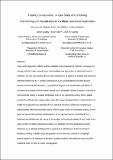Files in this item
Trading Consequences : a case study of combining text mining and visualisation to facilitate document exploration
Item metadata
| dc.contributor.author | Hinrichs, Uta | |
| dc.contributor.author | Alex, Beatrice | |
| dc.contributor.author | Clifford, Jim | |
| dc.contributor.author | Watson, Andrew | |
| dc.contributor.author | Quigley, Aaron John | |
| dc.contributor.author | Klein, Ewan | |
| dc.contributor.author | Coates, Colin M. | |
| dc.date.accessioned | 2017-10-12T23:32:00Z | |
| dc.date.available | 2017-10-12T23:32:00Z | |
| dc.date.issued | 2015-12-01 | |
| dc.identifier | 205728022 | |
| dc.identifier | 5b91e505-1131-4bbe-8b0c-2807bc4c5eef | |
| dc.identifier | 84974657790 | |
| dc.identifier | 000367449700007 | |
| dc.identifier.citation | Hinrichs , U , Alex , B , Clifford , J , Watson , A , Quigley , A J , Klein , E & Coates , C M 2015 , ' Trading Consequences : a case study of combining text mining and visualisation to facilitate document exploration ' , Digital Scholarship in the Humanities (DSH) , vol. 30 , no. Supplement 1 , pp. i50-i75 . https://doi.org/10.1093/llc/fqv046 | en |
| dc.identifier.issn | 2055-768X | |
| dc.identifier.other | ORCID: /0000-0002-5274-6889/work/34040086 | |
| dc.identifier.uri | https://hdl.handle.net/10023/11840 | |
| dc.description.abstract | Large-scale digitization efforts and the availability of computational methods, including text mining and information visualization, have enabled new approaches to historical research. However, we lack case studies of how these methods can be applied in practice and what their potential impact may be. Trading Consequences is an interdisciplinary research project between environmental historians, computational linguists and visualization specialists. It combines text mining and information visualization alongside traditional research methods in environmental history to explore commodity trade in the nineteenth century from a global perspective. Along with a unique data corpus, this project developed three visual interfaces to enable the exploration and analysis of four historical document collections, consisting of approximately 200,000 documents and 11 million pages related to commodity trading. In this paper we discuss the potential and limitations of our approach based on feedback from historians we elicited over the course of this project. Informing the design of such tools in the larger context of digital humanities projects, our findings show that visualization-based interfaces are a valuable starting point to large-scale explorations in historical research. Besides providing multiple visual perspectives on the document collection to highlight general patterns, it is important to provide a context in which these patterns occur and offer analytical tools for more in-depth investigations. | |
| dc.format.extent | 2065089 | |
| dc.language.iso | eng | |
| dc.relation.ispartof | Digital Scholarship in the Humanities (DSH) | en |
| dc.subject | QA75 Electronic computers. Computer science | en |
| dc.subject | D History General and Old World | en |
| dc.subject | NDAS | en |
| dc.subject.lcc | QA75 | en |
| dc.subject.lcc | D | en |
| dc.title | Trading Consequences : a case study of combining text mining and visualisation to facilitate document exploration | en |
| dc.type | Journal article | en |
| dc.contributor.institution | University of St Andrews. School of Computer Science | en |
| dc.identifier.doi | 10.1093/llc/fqv046 | |
| dc.description.status | Peer reviewed | en |
| dc.date.embargoedUntil | 2017-10-12 |
This item appears in the following Collection(s)
Items in the St Andrews Research Repository are protected by copyright, with all rights reserved, unless otherwise indicated.

